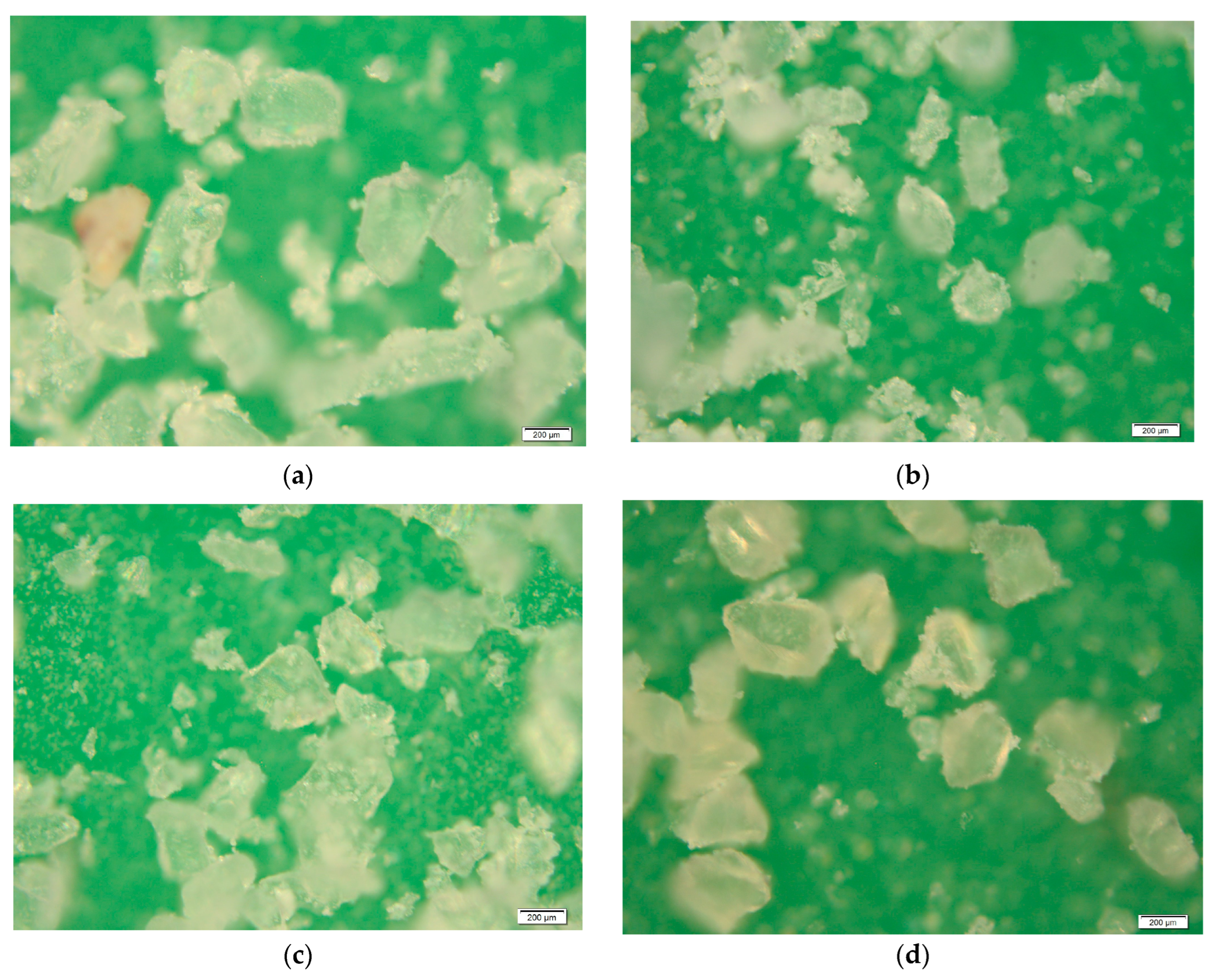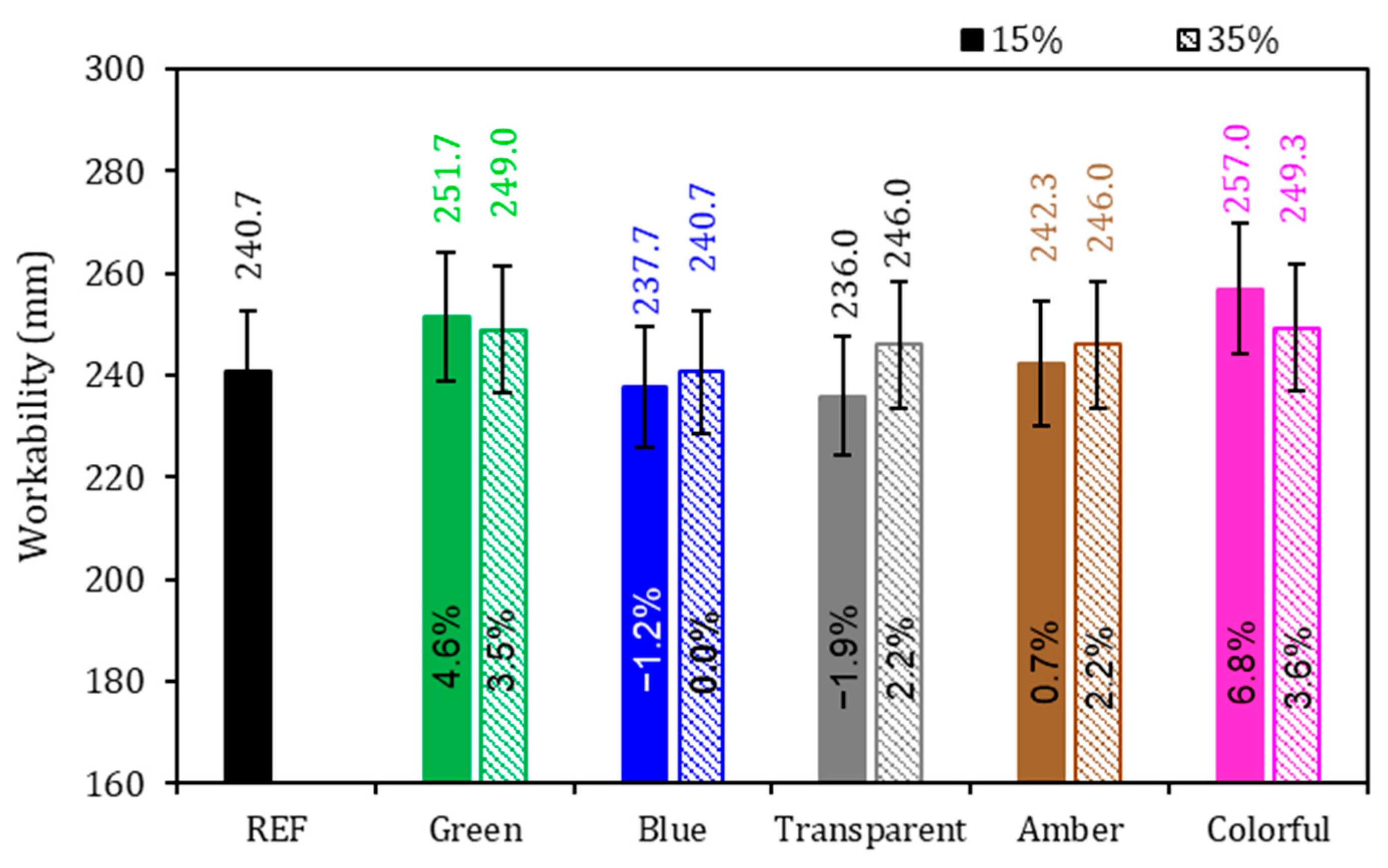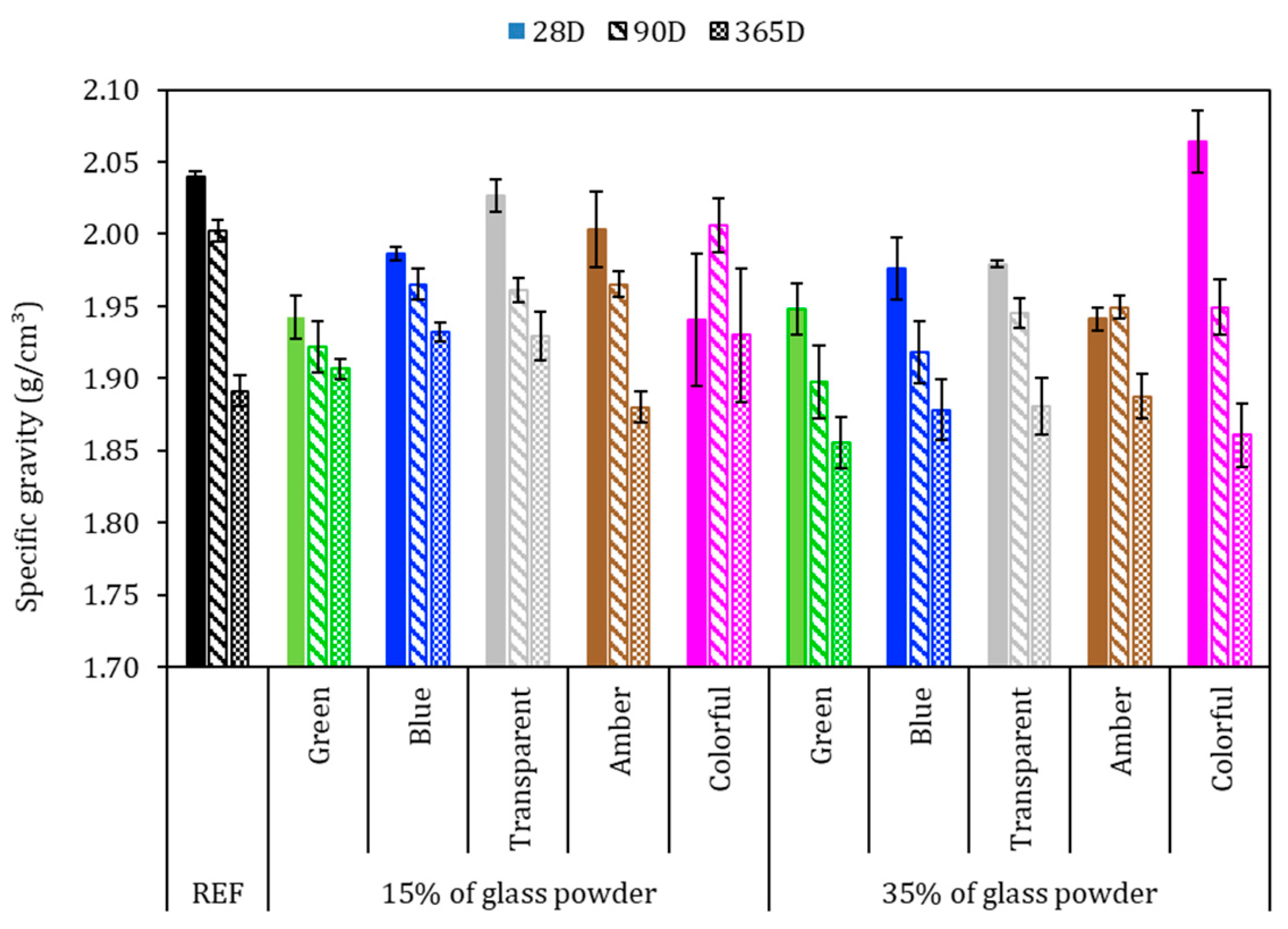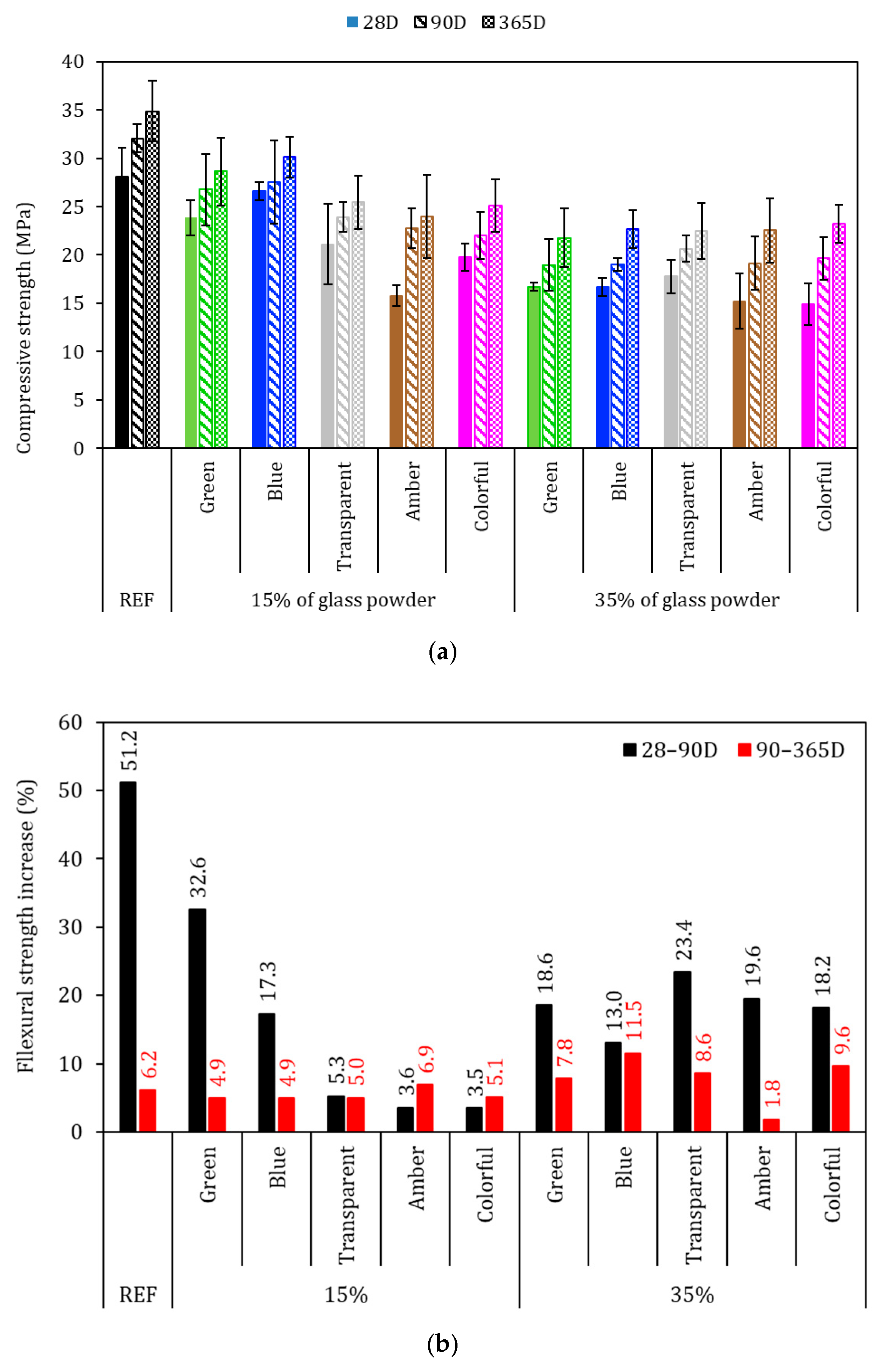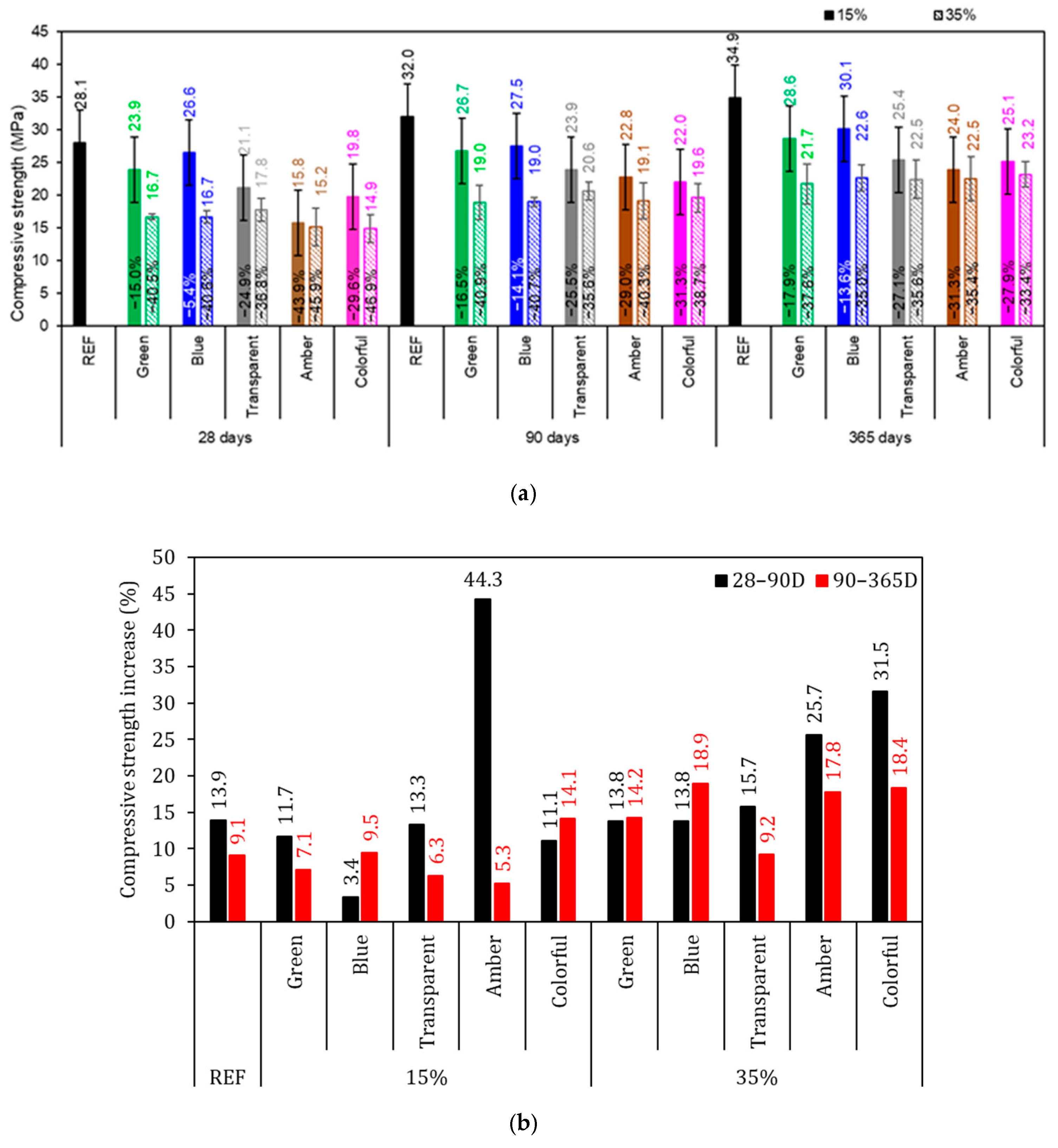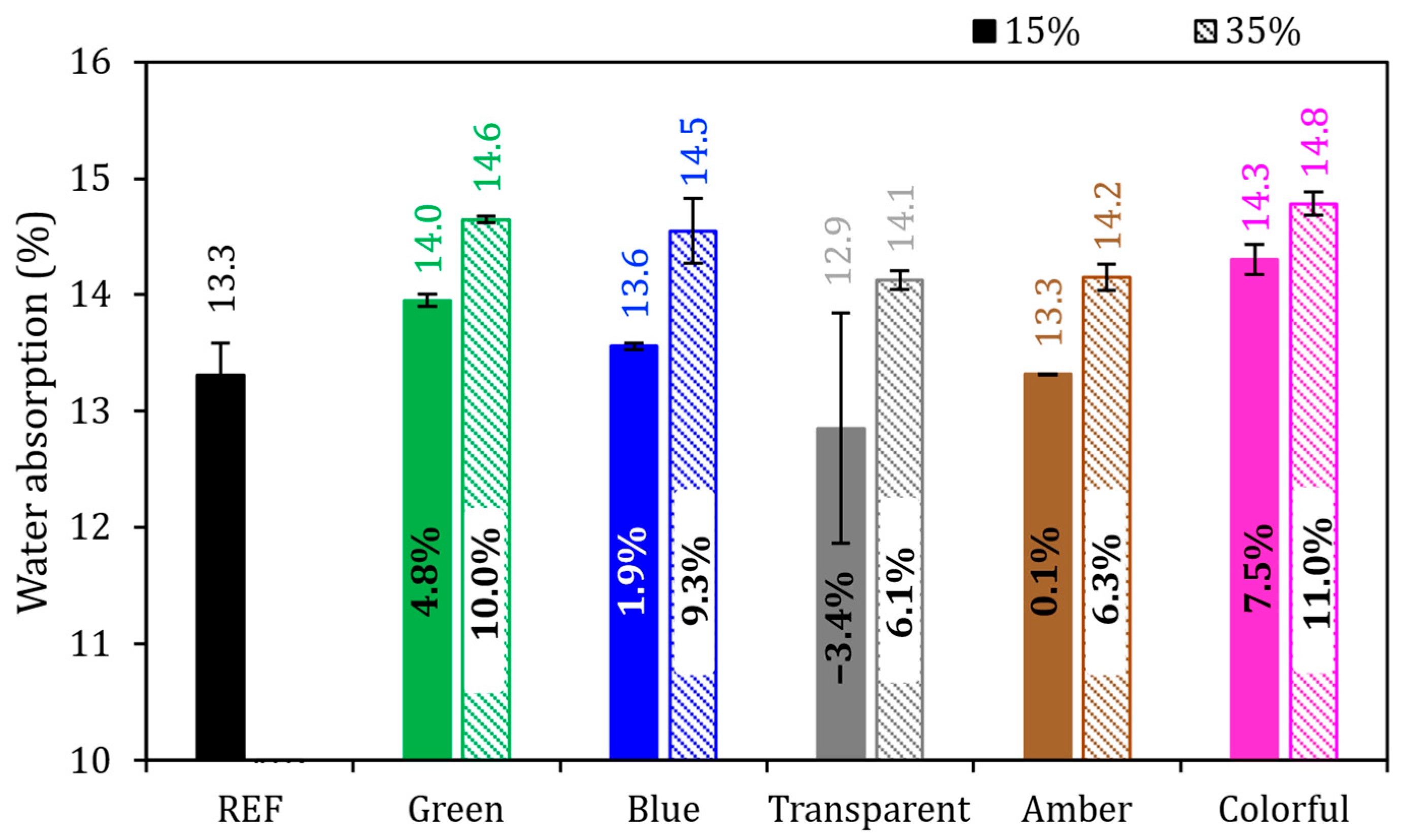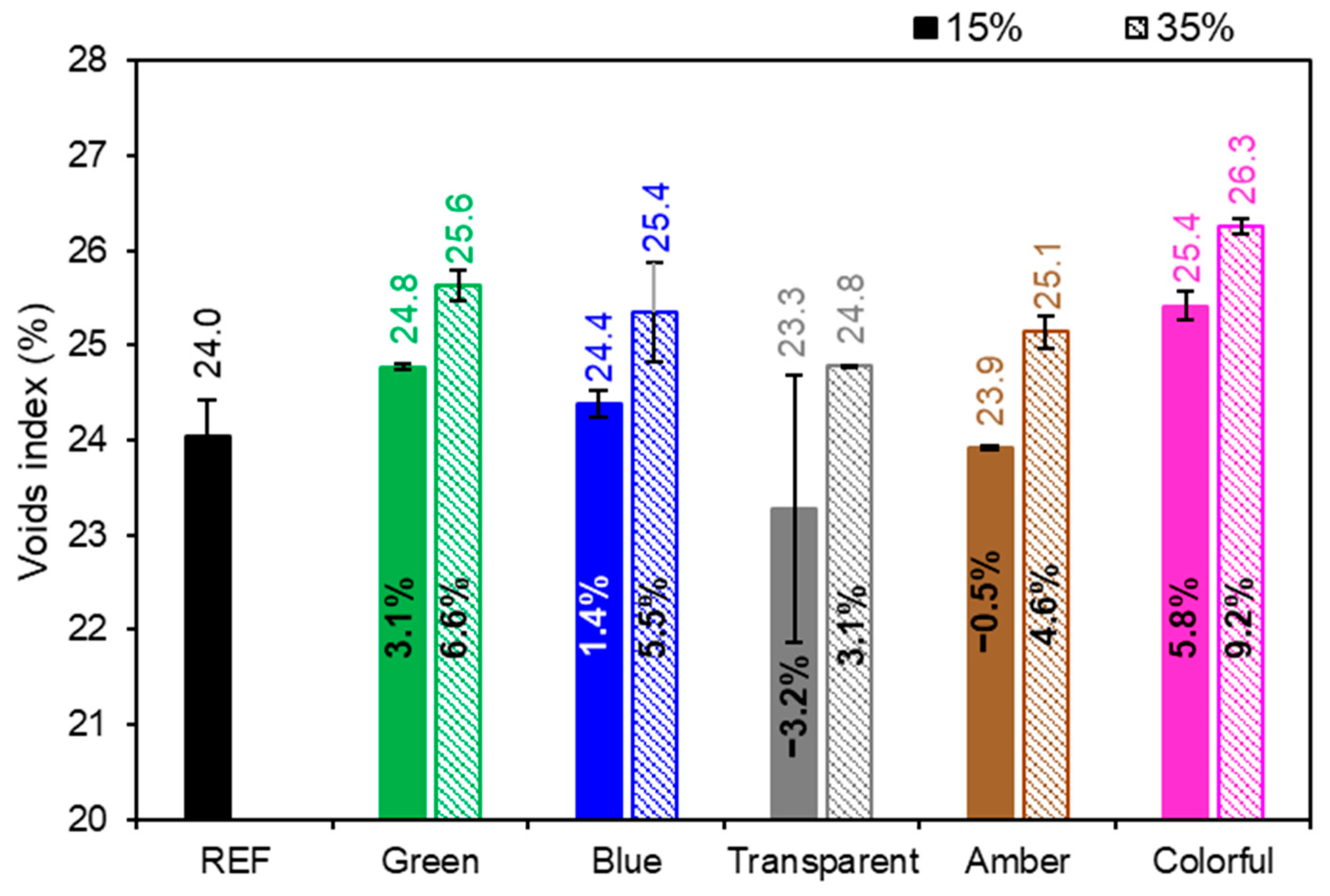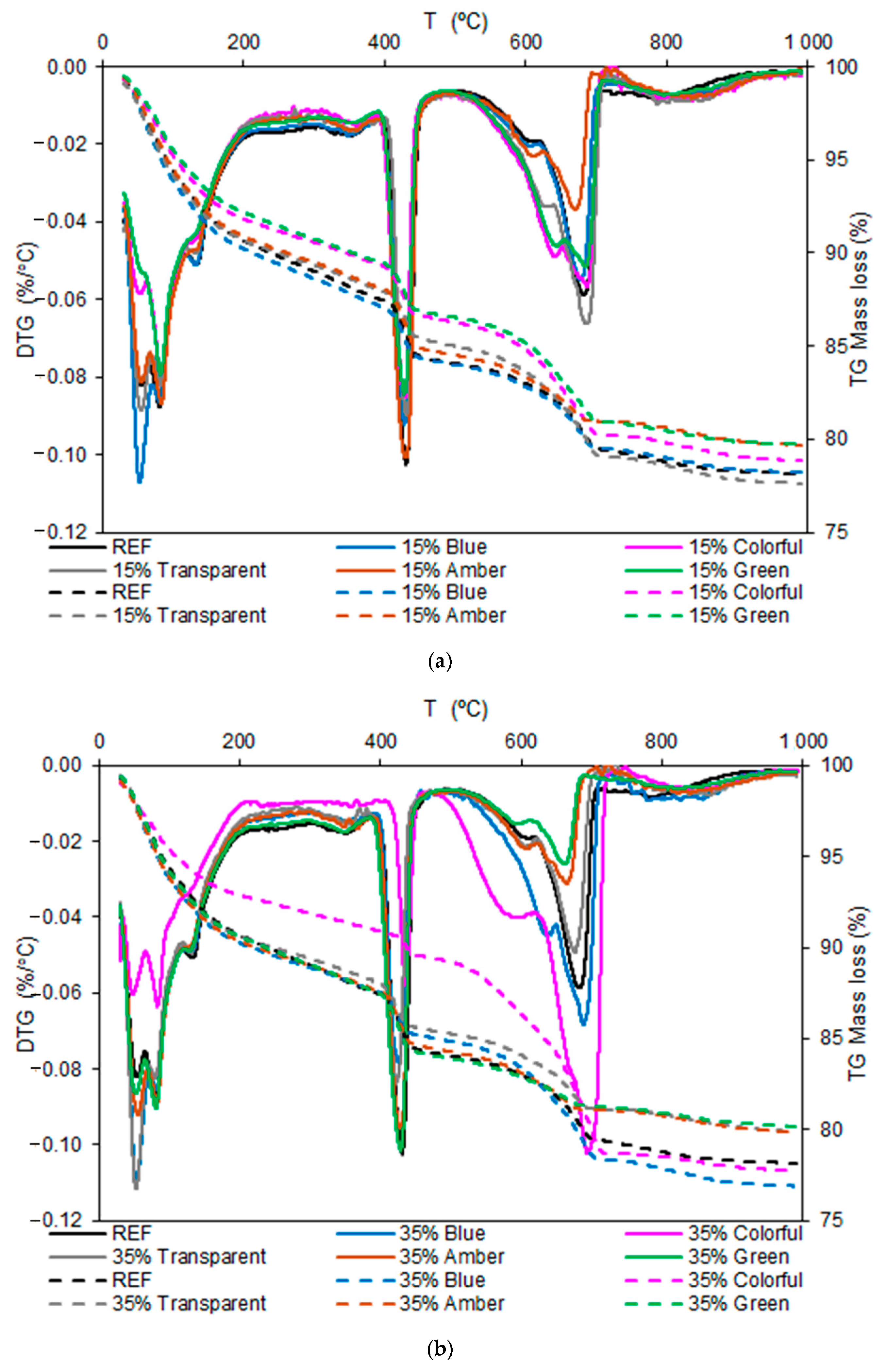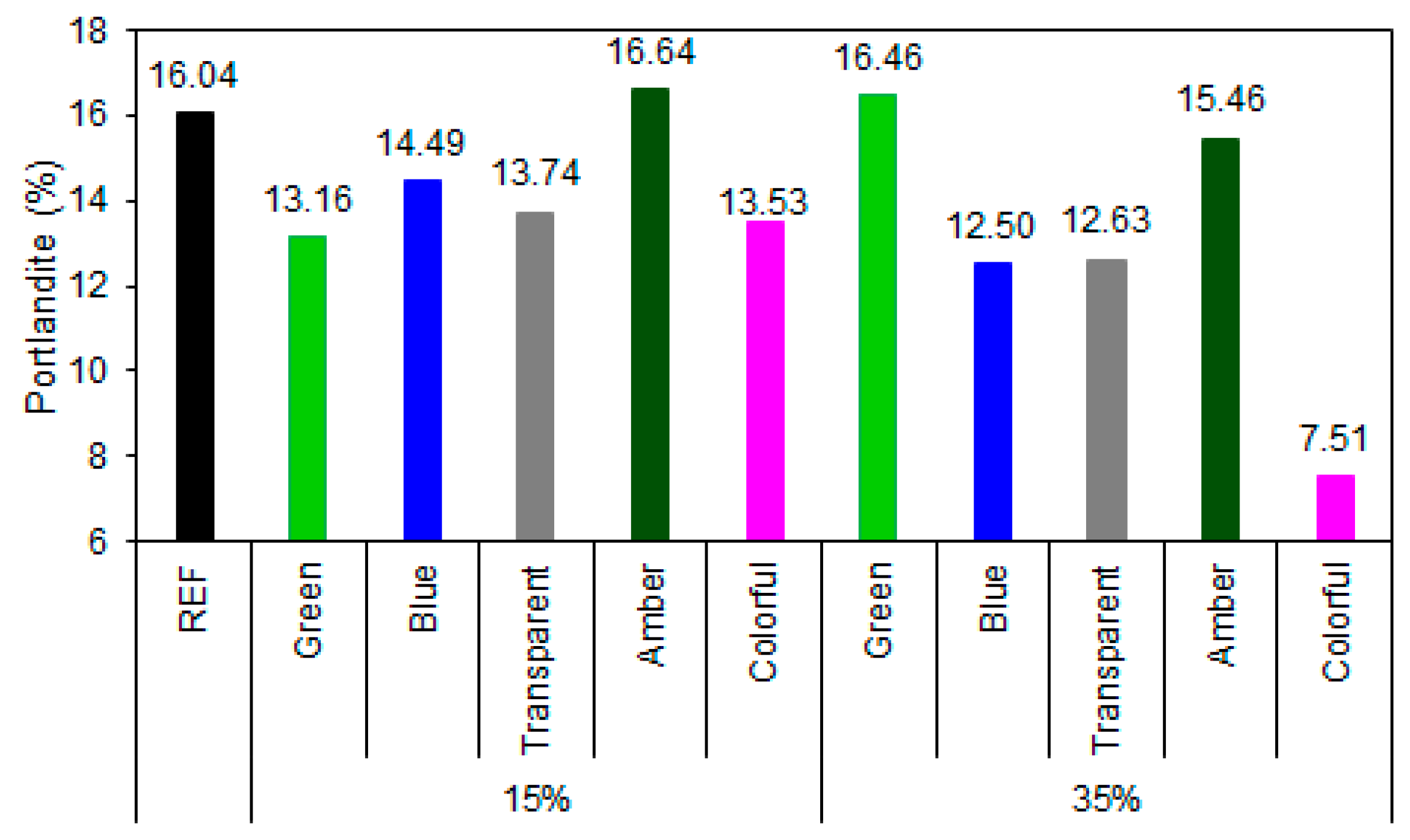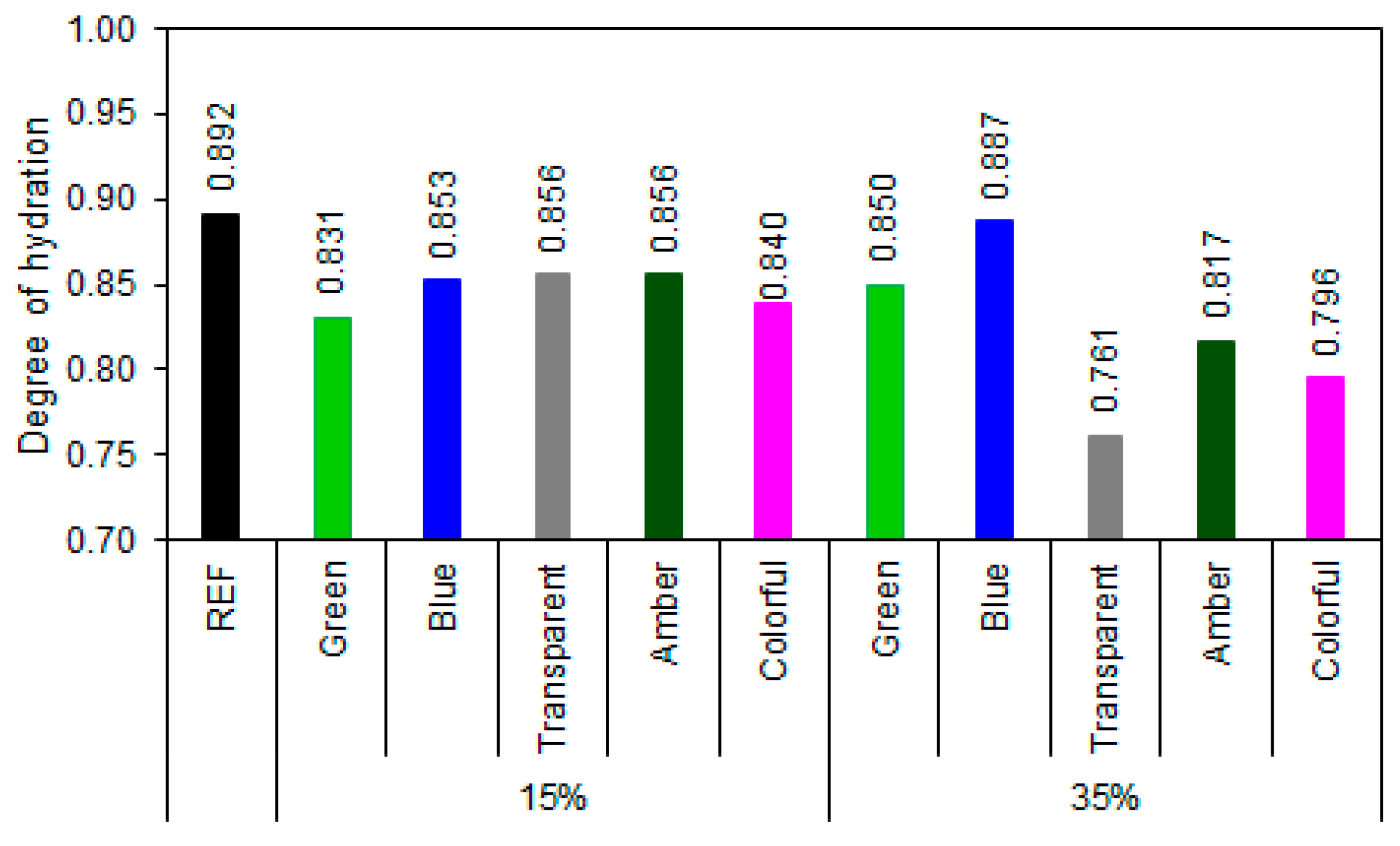3.2.1. Mechanical Properties
Figure 8 shows the apparent specific gravity of the mortars after 28, 90, and 365 days of cement hydration. In general, the apparent specific gravity in the hardened state decreased over the hydration time, which may be attributed to the free water evaporation. However, for this test, there was no behavioral tendency attributed to the amount or color of ground glass. The REF series with 28, 90, and 365 days achieved 2.04, 2.00, and 1.89 g/cm
3, respectively, that is, a reduction of 7.3% from 28 to 365 days. With 28 days, except in the sample with 35% colorful glass, all glass-added series presented lower specific gravity than did REF; however the variation of the samples was less than 5% in comparison to the REF series.
The results showed that the higher the proportion of ground glass replacing the cement, the lower the apparent specific gravity. This phenomenon was more evident in the 35% glass-added series. This can be explained by the lower cement content, which resulted in a less compact product since Portland cement has a specific gravity of 3.11 g/cm
3 and ground glass has one of 2.44 g/cm
3, as observed by Jochem et al. [
15].
Concerning 365 days, these samples followed the trend of reducing the specific gravity due to the increase in the hydration period, in which the loss of free water occurs through evaporation. This can be attributed to the smooth surface of the glass, which does not absorb water and may result in weak adhesion with hydrated cement products, resulting in a weaker bond between the glass and the cement paste [
58]. As verified by the granulometric analysis of ground glasses, more than 70% of these samples are less than 150 μm in size and may be considered a pozzolanic material [
59]. Samples with 15% colorful added glass at 90 days and 365 days presented a specific gravity greater than or equal to that of the REF series. This means the glass powder might have worked as a filler or reacted with Portland cement, precipitating in new hydrated products, densifying the matrix microstructure [
60].
A pozzolanic reaction occurs when pozzolanic materials, such as ground glass, react with the free lime present in the cement matrix, forming new hydration compounds that contribute to the development of additional mechanical strength. However, the size of the glass particles can influence the extent and speed of this reaction. This lack of significant pozzolanic reaction may explain the decrease in mortar strength as the proportion of ground glass increases [
61].
The flexural strength of the mortars was evaluated after 28, 90, and 365 days of hydration and is presented in
Figure 9, with the black bars in
Figure 9a representing the standard deviation. The flexural strength results presented different behaviors with different hydration times; at 28 days, all glass-added series presented higher strength in comparison with REF series (4.3 MPa), which was inconsistent with the specific gravity (
Figure 8—where the glass-added series presented lower values than did REF), as it was expected that the mechanical strength would be lower, which did not occur. This behavior suggests more efficient hydration in the first days, resulting in higher strength for the glass-added series. This effect may be attributed to the higher water disponible for cement hydration in the first days and to the glass filler effect, which was largely evident from the 15% transparent and colorful series achieving 5.7 MPa, which represents a 34.6% higher increase compared to the REF series. This phenomenon may also due the better cement hydration and matrix densification [
48,
61,
62,
63].
The flexural strength with 90 days of cement hydration was 6.5 MPa for the REF series, and all the glass-added series achieved a lower average in comparison to the REF series at this time. Although the averages were lower, for 15% glasses added, the reduction in the flexural strength ranged from −5 to −10%, while for the 35% glasses-added series, the average results ranged from −10 to −21% in comparison to REF. These results are associated with the continuous cement hydration of the REF series, where there was an increase in the flexural strength from 4.3 to 6.5 MPa, while that of the glass added series ranged from 4.3 to 6.1 MPa. This might have occurred due to the fact that the thinner part of the powder glass had already been consumed in the first days (until 28 days). From this moment, the remaining glass did not have enough time to be dissolved and react with calcium hydroxide [
64]. The flexural strength at 365 days of cement hydration had a 6.9 MPa for the REF series, and at 90 days, no glasses-added series achieved an average strength higher than that of REF at this time.
Figure 9b presents the strength increase from 28 to 90 days and from 90 to 365 days of cement hydration. The REF series had a 51.2% increase in flexural strength for 28–90 D, and no glasses-added series presented a higher strength increase than did REF series for this hydration time. This behavior indicated that cement is faster than glass in providing strength increase for the first days of cement hydration, as evidenced by the average 15.5% strength increase of the glass-added series. However, for 90–365 D, the cement hydration slowed down, and the strength increased was in the same scale of that of the glasses-added series. The REF series achieved a 6.2% strength increase in this period, and the glasses-added series achieved a 6.6% in strength increase on average, which shows that the binder with glass particles had a reaction similar to that of a cement without glass. Also, the findings suggested that there was late hydration of the cement with glass in the 35% glass-added series, where, with the exception of the amber series, all of the 35% glass-added series presented a higher strength increase than did the REF series. This may be explained by the thinner part of the glass being consumed in the first 28 D, with the remaining glass needing time to be dissolved; thus, there is a need to have more than 15% of glass to achieve continuous late hydration [
15,
65].
The two effects were evaluated with ANOVA at a 95% confidence level (
Table 5), and it was observed that the partial replacement of cement by glass (15 and 35%) affected the flexural strength at the hydration times analyzed (
p-value < 0.05). On the other hand, the glass color did not significantly affect the flexural strength at the hydration times analyzed (
p-value > 0.05).
Figure shows the results of compressive strength at 28, 90, and 365 days. At all hydration times analyzed, the REF series achieved the highest compressive strength, which was expected since it is the sample with the highest content of cementitious material (
Figure 10a). The REF series achieved 28.1, 32.0, and 34.9 MPa at, 28, 90, and 365 days of cement hydration, respectively. Is it possible to discern a trend in behavior in this strength test. The samples with a 15% replacement of cement with glass had a 23% lower strength compared to the REF series, independent of the hydration time analyzed. Similarly to this, series with 35% replacement had a 39% lower strength than the REF series. For all specimens, considerable improvement was noted in the magnitudes of compressive strength as the curing period increased (
Figure 10b). This may be a result of the continuous progression in the hydration process with curing time forming hydration products between the cement grains, filling open pores, and increasing the ratio of hydration products, ultimately improving mechanical properties [
66].
According to Ramadan et al. [
53] and Shwita et al. [
67], sodium-rich glass waste (equivalent to the blue and amber glass in this study) has pozzolanic potential due to the high content of amorphous silica (SiO
2) (in order of 70%), the high area surface, and the presence of very fine particles (30% less than 20 µm in blue and amber colors, for example), which allow it to effectively participate in the cement hydration process and thus improve the mechanical properties (
Figure 10b—15% amber and 35% colorful). This was confirmed by the average strength increase, which in the REF series was 13.9% and 9.1%, for 28–90 D and 90–365 D, respectively; thus, the 15% series had a strength increase in the same proportion to that of the REF series; meanwhile, the 35% series had a compressive strength increase generally higher than that of the REF series.
A reduction in mechanical strength when using waste glass was also reported by Mohamed et al. [
64], who attributed this to the low bond phases built after significant dilution of Portland cement via the exclusion of glass since the CaO and Al
2O
3 content is also limited. Furthermore, due to the dilution of Portland cement, the amount of released Ca(OH)
2 produced during the hydration process, essential for activating glass elimination, is reduced; therefore, the amount of binder phases produced from the pozzolanic reaction of the glass with calcium hydroxide elimination is not sufficient to compensate for the reduction in tensile strength. Also, the high level of glass destruction makes it difficult for it to disperse well in the prepared cementitious composite [
64].
The beneficial effect caused by using glass waste powder is slow and gradual, being observed only after 28 D of cement hydration, according to Soliman and Tagnit-Hamou [
52]. Therefore, it was expected that samples with ground glass would present compressive strength similar to that of the REF series from 90 D onwards since glass, when finely ground, may present a pozzolanic reaction and form additional hydrated products in the cementitious matrix. In the work by Zizková [
68], the compressive strength of mixtures containing powder glass waste with 90 D of hydration was comparable to that of reference pastes. This result was due to the average diameter of the glass waste being at least 300% coarser than the average diameter of the Portland cement used; the ground glass worked as a filler, filling the voids and densifying the interfacial transition zone, without presenting a pozzolanic reaction. Also, mortars with a low proportion of ground glass replacing Portland cement obtained compressive strength results closer to the reference value, while mortars with a higher ground-glass content resulted in lower strength due to lower cement consumption, which leads to a reduction in the amount of clinker compounds, mainly material for the development of strength [
19,
26,
69].
The two effects were evaluated with ANOVA at a 95% confidence level, and it was observed that partial replacement of cement by glass (15 and 35%) and the glass color affected the compressive strength at the hydrations times analyzed (
p-value < 0.05) (
Table 6).
Du and Tan [
28] and Soliman and Tagnit-Hamou [
52] achieved results superior to the REF at 90 and 365 days, respectively; however, in their research, the average particle size of the powder glass was 10 µm, practically 300% smaller than that used in this study (except for the size of the green ground glass). In other words, the glass waste used by the authors had an average particle diameter comparable to that of Portland cement. Due to this, the glass waste showed pozzolanic reaction, resulting in an increase in mechanical strength. In this sense, it is extremely important to control the size of ground glass waste particles in the production of modified cementitious mortars, as this may significantly affect their reactivity and, consequently, their mechanical strength. Thus, in parallel to the research presented here, the compressive strength comparable to the reference was not observed with the increase in the hydration period, opposite to what is indicated in the literature [
70,
71]. This may be due to the average diameter of the glasses that are at least 300% coarser than Portland cement preventing a pozzolanic reaction.
3.2.2. Physical Properties
Figure 11 presents water absorption by immersion. The REF series achieved 13.3%, and with the exception of the 15% transparent series, all the series had higher values than did REF. It was identified that the higher the proportion of Portland cement being replaced by ground glass, the higher the absorption index was in percentage; this means that the 35% series had a higher index in comparison to the 15% series. It was possible to analyze the behavior of different substitution levels and their relationship with absorption in samples in the hardened state after 28 days. The lowest values identified were from the 15% transparent series, with an absorption value of 12.9%, and from the 15% amber series, with a value of 13.3%. On the other hand, the highest absorption values were recorded in the 35% green series, with 14.6% absorption, and in the 35% colorful series, with 14.8% water absorption.
Mortars with a 15% cement replacement by ground glass showed an average water absorption of 13.6%. Comparing the average value of 15% series directly with the REF value, we found that the water absorption increased by 1.9%. For mortars with 35% of replacement content, the water absorption average reached 14.5%, with the average value being 9.3% higher than that of the REF series. This water absorption being close to the reference, especially in samples with 15% replacement, occurred due to the refinement of the porous structure of the matrix produced, possibly due to the filler effect of the addition, which left the structure relatively dense, per what was observed by Ali-Boucetta et al. [
72].
The two effects were evaluated with ANOVA at a 95% confidence level (
Table 7), and it was observed that partial replacement of cement by glass (15 and 35%) affected the water absorption of the mortars (
p-value < 0.05), but the glass color did not affect the water absorption at the hydration times analyzed (
p-value > 0.05).
Figure 12 presents the void index (open porosity), the REF achieved a 24% void index, and as presented in the water absorption, with the exception of 15% transparent series, all series had higher values than did the REF series. It can be noted that samples with a higher content of powder glass replacing Portland cement had a higher void index, meaning that the 35% series had a higher void index in comparison to the 15% series. The ANOVA performed indicated that the amount of glass replacing cement was statistically significant (
p-value < 0.05) and affected the void index of the mortars (
Table 8). On the other hand, the glass color did not affect the void index of the mortars (
p-value > 0.05). The void index also increased because mortars with a higher glass content have coarser particles in their granulometry, increasing the intergranular void spaces and retaining more water, which is in line with the water absorption test (
Figure 11). The void index of a cementitious material is influenced by its constituents by the hydration process that leads to the formation and alteration of the microstructure. Replacing cement with glass powder may increase the porosity of the material due to the Portland cement dilution effect. Due to the reduction of cement particles and glass particles that are non-absorbent, this results in more free water in the matrix. As the material hydrates and dries, water escapes and makes the mortar more porous [
26].
The thermogravimetry curves of the pastes at 28 days are presented in
Figure 13. The first axis presents the derived of mass loss, and the secondary axes present the mass loss.
Figure 13a shows that the DTG peaks were similar between the glass-containing and REF samples, indicating that the ground glass did not affect the hydration reactions. However, the intensity of the peaks varies, with a reduction in the calcium hydroxide (CH) formation peak, which may indicate a pozzolanic reaction of the glass, which consumes Ca(OH)
2 and forms additional C-S-H. Regarding mass loss, it can be seen that the green, colored, and amber glass samples showed lower mass loss, indicating a smaller amount of hydrated products than that of the REF. Glass color slightly influenced reactivity, but all glass types maintained a similar behavior.
Figure 13b shows an even more significant reduction in the portlandite peak, especially for the colored glass, indicating that the greater the substitution with glass was, the more CH was consumed by the pozzolanic reaction. In terms of mass loss, fewer hydrated products were formed compared with the REF and 15% replacement samples due to the greater replacement of cement by glass. The differences between the glass colors became more pronounced at 35% than at 15%, indicating that glass composition has a greater influence as the glass proportion increases.
One factor associated with the reactivity of glass samples with different colors may be the chemical elements that compose the glass, ensuring the color pattern [
26]. In the case of green glass, elements such as Fe
3+, Al
3+, and SO
3−2 are present. Iron ions have moderate reactivity with the ions in the cement solution, while aluminum and sulfate ions are highly reactive and therefore likely participate in cement hydration reactions. In the case of blue glass, Al
3+ and K
+ ions are present in its composition. We already know that aluminum participates in the reactions, while potassium ions have high reactivity with the oxygen atoms on the surface of the hydrated products. This is especially true because it is a chemical element in the alkali metals family, which has high solubility in aqueous solutions. Therefore, some reactivity of the glass powder is expected to be detected, potentially through reactions that form hydration products or doping of the hydration products, which can primarily measure mechanical strength results [
52,
73].
The REF presented a portlandite content of 16.04%, a value expected based on normal clinker hydration. With the replacement of 15% by ground glass, a moderate reduction in portlandite contents was observed for green (13.16%), transparent (13.74%), and colored (13.53%) glass, suggesting an active, albeit partial, pozzolanic action, in agreement with the literature [
74,
75]. On the other hand, the sample with amber glass showed an increase in portlandite content (16.64%), indicating low reactivity (
Figure 14).
At 35% substitution, the results became more pronounced. Colored glass had the lowest portlandite content (7.51%), demonstrating high pozzolanic reactivity, while transparent (12.63%) and blue (12.50%) glasses also showed satisfactory performance, with significant calcium hydroxide consumption. In contrast, green (16.46%) and amber (15.46%) glasses presented similar contents to those of REF, even with a higher substitution proportion, reinforcing the hypothesis of the low reactivity of these compositions. This behavior may be related to the chemical composition due to the metal oxides used as coloring agents or the presence of impurities, which can reduce the solubility of amorphous silica and compromise the glass’s reactivity [
76]. The influence of color is even more evident when the surface area of the glass powders is analyzed; powders with a larger surface area are expected to have greater reactivity potential [
52]. In the case observed in this study, the blue and green samples had an equivalent amount of portlandite to that of the clear sample when 15% of the glass was replaced. At 35%, the green glass sample obtained more portlandite than did the REF sample, demonstrating the influence of color on the composite’s properties.
The degree-of-hydration (
Figure 15) assessment indicates that most samples with ground-glass replacement performed satisfactorily in terms of binder hydration. REF exhibited a degree of hydration of 0.892, representing the maximum expected limit for complete hydration of Portland cement without additions. Among the samples with 15% glass, the values ranged from 0.831 to 0.856, or 93.2 to 96.0% of the hydration of REF series, indicating that this replacement does not significantly compromise the evolution of hydration reactions. The blue, transparent, and amber glasses showed values close to those of REF, suggesting that despite the dilution of the clinker, the presence of glass may favor hydration, possibly acting as a nucleating agent. At 35% replacement, the results were more diverse: blue glass maintained a high degree of hydration (99.4% of the REF series hydration), indicating good compatibility with the cementitious matrix, while transparent glass showed a sharp decrease (85.3% of the REF series hydration), revealing a possible dilution effect predominating over any pozzolanic contribution. Colorful and amber glasses also showed a reduction in the degree of hydration (89.2% and 91.6%, respectively).
The combined analysis of the degree of hydration and portlandite content data allows for a more robust assessment of the efficiency of the hydration reactions and the pozzolanic activity of the different types of ground glass [
77,
78,
79]. With the incorporation of 15% glass, all samples maintained a high degree of hydration (>93%), and moderate reductions in portlandite contents were observed for the green, transparent, blue, and colored glasses, demonstrating moderate pozzolanic activity. However, the amber glass, despite presenting a high degree of hydration (96%), exhibited a higher portlandite content than did the reference (3.74% higher), suggesting predominantly inert behavior.
With 35% substitution, the differences between the glass types became more pronounced. The blue glass demonstrated excellent performance, with a degree of hydration (99.4%) almost equal to that of the REF sample and a significant reduction in portlandite content (12.50%), demonstrating synergy between cement hydration and the pozzolanic activity of the glass. Similarly, colored glass showed the highest portlandite consumption (7.51%), even with a lower degree of hydration (0.796), indicating high pozzolanic reactivity. On the other hand, transparent glass, despite promoting portlandite reduction, showed the lowest degree of hydration (0.761), indicating that at higher contents, the dilution effect outweighs the gains from pozzolanic activity. Amber glass maintained inert behavior, with a high portlandite content (15.46%) and low hydration (0.817), while green glass showed contradictory results, with an increase in portlandite (16.46%) even with a high degree of hydration (0.850), which can be attributed to the low reactivity of the green composition or the presence of impurities that inhibit the pozzolanic reaction [
26].

